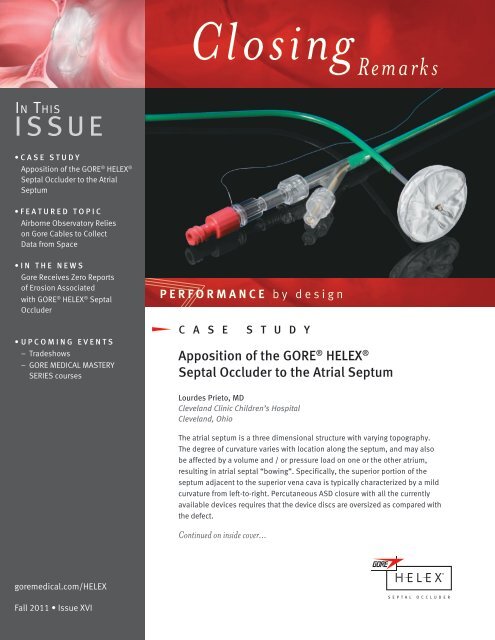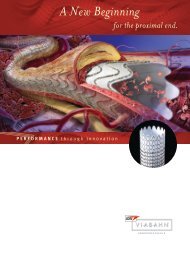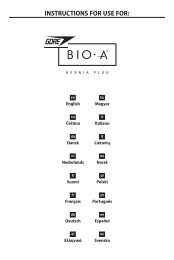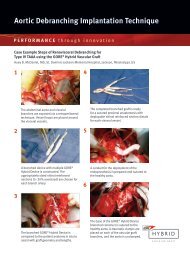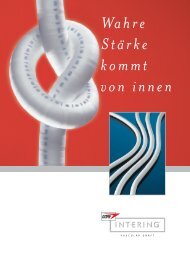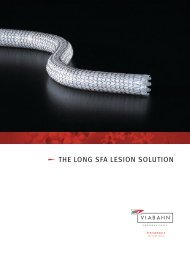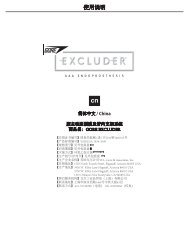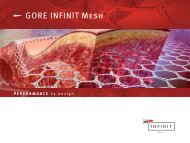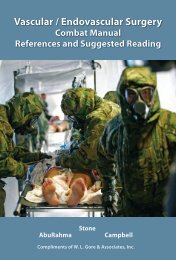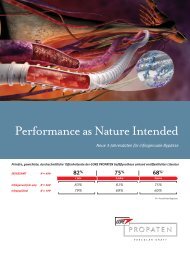Create successful ePaper yourself
Turn your PDF publications into a flip-book with our unique Google optimized e-Paper software.
Closing Rem a rk s<br />
In This<br />
I S S U E<br />
• C A S E S T U D Y<br />
Apposition of the GORE ® HELEX ®<br />
Septal Occluder to the Atrial<br />
Septum<br />
• F E A T U R E D T O P I C<br />
Airborne Observatory Relies<br />
on <strong>Gore</strong> Cables to Collect<br />
Data from Space<br />
• I N T H E N E W S<br />
<strong>Gore</strong> Receives Zero Reports<br />
of Erosion Associated<br />
with GORE ® HELEX ® Septal<br />
Occluder<br />
• U P C O M I N G E V E N T S<br />
– Tradeshows<br />
– GORE MEDICAL MASTERY<br />
SERIES courses<br />
P E R F O R M A N C E b y d e s i g n<br />
C A S E S T U D Y<br />
Apposition of the GORE ® HELEX ®<br />
Septal Occluder to the Atrial Septum<br />
Lourdes Prieto, MD<br />
Cleveland Clinic Children’s Hospital<br />
Cleveland, Ohio<br />
The atrial septum is a three dimensional structure with varying topography.<br />
The degree of curvature varies with location along the septum, and may also<br />
be affected by a volume and / or pressure load on one or the other atrium,<br />
resulting in atrial septal “bowing”. Specifically, the superior portion of the<br />
septum adjacent to the superior vena cava is typically characterized by a mild<br />
curvature from left-to-right. Percutaneous ASD closure with all the currently<br />
available devices requires that the device discs are oversized as compared with<br />
the defect.<br />
Continued on inside cover...<br />
goremedical.com/HELEX<br />
Fall 2011 • Issue XVI
Apposition of the GORE ® HELEX ® Septal Occluder to the Atrial Septum<br />
Continued from cover...<br />
Figure 1. Subcostal short axis view demonstrating<br />
the ASD with adequate superior (SVC) and<br />
postero-inferior (IVC) rims measuring 7 mm and<br />
12 mm respectively. (IVC = inferior vena cava,<br />
LA = left atrium, RA = right atrium, SVC = superior<br />
vena cava.<br />
Figure 2. Parasternal short axis view demonstrating<br />
the deficient antero-superior (aortic) rim measuring<br />
3 mm. ASD = atrial septal defect, LA = left atrium,<br />
RA = right atrium.<br />
Figure 3. ICE image demonstrating the stop-flow<br />
diameter of the ASD measured at 11.6 mm.<br />
The extent to which the portion of the<br />
discs around the defect conforms to the<br />
atrial septal surface is determined by the<br />
anatomy of that surface, the mechanism<br />
by which the device closes the defect,<br />
and the structure of the device.<br />
The GORE ® HELEX ® Septal Occluder is a<br />
non-self centering device with left and<br />
right atrial discs that will generally<br />
conform to the atrial septal surface.<br />
Despite these features, it is sometimes<br />
observed that the superior portion of the<br />
right atrial disc along the SVC rim does<br />
not appose well to the septum, as the<br />
device cannot bend to follow the atrial<br />
septal curvature. The device may then<br />
appear to protrude towards the SVC.<br />
Although this appearance may raise<br />
concern about interference with SVC<br />
flow, to date we have not encountered<br />
a case where obstruction of SVC<br />
flow was observed clinically or<br />
echocardiographically. We have been<br />
careful to interrogate the SVC flow by<br />
color and pulse Doppler with either<br />
TEE or ICE (one or the other imaging<br />
technique is used for all septal closures<br />
in our practice) in the catheterization<br />
laboratory after locking the device as<br />
well as after full release, and no<br />
significant obstruction has ever been<br />
detected. Over time some patients<br />
demonstrate improved apposition of the<br />
right atrial disc of the device towards the<br />
septum, but even when that does not<br />
occur there have been no cases of<br />
compromised SVC flow during follow-up.<br />
The following case illustrates the<br />
above observations:<br />
A seven-year-old girl with a small to<br />
moderate secundum atrial septal defect<br />
and very mild pulmonary valve stenosis<br />
presented for device closure. The defect<br />
measured 7 – 8 mm by transthoracic<br />
echocardiogram and the right ventricle<br />
was enlarged. The ASD had adequate<br />
superior (SVC) and postero-inferior (IVC)<br />
rims (Figure 1), and relatively deficient<br />
antero-superior (aortic) rim (Figure 2).<br />
At catheterization a Q p<br />
/ Q s<br />
of 1.6 was<br />
measured under general anesthesia. A<br />
5 mm gradient was measured across the<br />
pulmonary valve. Pulmonary angiography<br />
demonstrated mild doming of the<br />
pulmonary valve and a relatively centrally<br />
located atrial septal defect with<br />
moderate opacification of the right<br />
ventricle. Intracardiac echocardiography<br />
(ICE) was utilized to guide the procedure<br />
along with fluoroscopy. Evaluation of the<br />
rims confirmed the previously described<br />
findings. The stop flow diameter was<br />
measured at 11 – 12 mm (Figure 3).<br />
A 25 mm GORE ® HELEX ® Device was<br />
chosen and successfully deployed<br />
around the aortic knob (Figure 4,<br />
Video 1*).<br />
The superior portion of the right atrial disc<br />
of the device around the SVC rim did not<br />
appose optimally to the right side of the<br />
atrial septum and protruded mildly<br />
towards the SVC. Color flow demonstrated<br />
no turbulence with laminar flow from the<br />
SVC to the right atrium. Right atrial<br />
angiography demonstrated a wellpositioned<br />
device with again some<br />
protrusion of the superior right atrial disc<br />
towards the SVC (Figure 5, Video 2*).<br />
No residual leak was identified by ICE or<br />
angiography. A transthoracic echocardiogram<br />
the following morning continued<br />
to demonstrate no residual leak and
Video 1*. ICE image post GORE ® HELEX ® Septal<br />
Occluder deployment demonstrating the device<br />
discs “hugging” the aorta. LA = left atrium,<br />
RA = right atrium.<br />
Video 2*. Right atrial angiogram in left<br />
anterior oblique / cranial angulation following<br />
the GORE ® HELEX ® Septal Occluder deployment<br />
shows no residual leak on levophase, and mild<br />
protrusion of the superior RA disc towards the SVC.<br />
Figure 4. ICE image post GORE ® HELEX ® Septal<br />
Occluder deployment demonstrating the device<br />
discs “hugging” the aorta. LA = left atrium,<br />
RA = right atrium.<br />
protrusion of the superior portion of the<br />
device into the SVC with no obstruction<br />
to SVC flow (Figures 6 – 7; Video 3*).<br />
The patient has been followed for<br />
one year and is doing well clinically.<br />
Device position appears unchanged by<br />
echocardiogram with persistent mild<br />
protrusion into the SVC without flow<br />
compromise (Figure 8 – 9; Video 4*).<br />
Right ventricular size and septal motion<br />
are normal. One possible concern<br />
regarding persistent protrusion of the<br />
device and lack of apposition to the<br />
septum is whether endothelialization<br />
of the portion of the device not in contact<br />
with the septum will occur. Experience<br />
with animal studies using devices that<br />
are too large for the size of the atrial<br />
septum, and therefore having a flared<br />
appearance with suboptimal apposition<br />
around the defect, have shown that<br />
areas of the device not in contact with<br />
the septum are covered with a similar<br />
layer of fibrous connective tissue and<br />
endothelial-like cells at portions making<br />
contact. In these animals, improved<br />
apposition of the atrial disc of the device<br />
to the septum was observed over time.<br />
We have not seen any instances of<br />
thrombus formation on protruding portions<br />
of the device, nor have any of our patients<br />
experienced a clinical event suggestive of<br />
pulmonary or systemic emboli.<br />
In summary, mild protrusion of portions<br />
of the GORE ® HELEX ® device into the<br />
right or left atria may occur due to the<br />
septal topography, or sometimes when<br />
devices are relatively large for the<br />
size of the heart. Provided there is no<br />
interference with any intracardiac<br />
structure, or obstruction to systemic or<br />
pulmonary venous return at the time of<br />
deployment, these protrusions do not<br />
result in any clinical problem. In some<br />
cases there is improved apposition of the<br />
atrial disc of the device to the atrial<br />
septum over time.<br />
Please refer to GORE ® HELEX ® Septal<br />
Occluder Instructions for Use at<br />
goremedical.com for a complete<br />
description of all indications,<br />
contradindications, warning,<br />
precautions and adverse events.<br />
This case study is not intended to<br />
express the views, opinions, or<br />
Figure 5. Still frame fluoroscopic image in the<br />
lateral projection showing a well positioned<br />
GORE ® HELEX ® Device with some protrusion of the<br />
superior RA disc towards the SVC. ICE = intracardiac<br />
echocardiography, LA = left atrium, RA = right atrium.<br />
recommendations of the device<br />
manufacturer, W. L. <strong>Gore</strong> & Associates,<br />
rather the views, opinions, or<br />
recommendations expressed herein<br />
are exclusively the authors’ own,<br />
and <strong>Gore</strong> excepts no liability for the<br />
accuracy or completeness or use of the<br />
information contained in this article.<br />
Continued on next page...
Apposition of the GORE ® HELEX ® Septal Occluder to the Atrial Septum<br />
Continued from previous page..<br />
Figure 6.<br />
Figure 8.<br />
Figure 7.<br />
Figure 9.<br />
Video 3*. Subcostal long and short axis views (Figures 6, 7, Video<br />
3*) obtained 24 hours after ASD closure demonstrating protrusion<br />
of the device towards the base of the SVC. Color Doppler shows<br />
laminar flow with no evidence of obstruction to SVC flow. (LA = left<br />
atrium, RA = right atrium,<br />
SVC = superior vena cava).<br />
Video 4*. Subcostal long and short axis views (Figures 8, 9, Video 4*)<br />
one year after ASD closure demonstrating persistent protrusion of<br />
the device towards the SVC. Color Doppler again shows laminar flow<br />
with no evidence of obstruction to SVC flow. (LA = left atrium, RA =<br />
right atrium, SVC = superior vena cava).<br />
* The video files referenced in these articles are<br />
available in our online version of the Closing Remarks<br />
newsletter: http://www.goremedical.com/HELEX/<br />
library/newsletters.
F E A T U R E D T O P I C<br />
Airborne Observatory Relies on <strong>Gore</strong> Cables<br />
to Collect Data from Space<br />
High above the earth’s stratosphere, a<br />
Boeing 747 jet is gathering information<br />
about star and planet formation millions<br />
of light-years away. The heavily modified<br />
jet is equipped with an infrared telescope<br />
that relies on <strong>Gore</strong> cables to capture data.<br />
Called the SOFIA project, the endeavor<br />
is a joint collaboration between the<br />
U.S. National Aeronautics and Space<br />
Administration (NASA) and the German<br />
Aerospace Center. <strong>Gore</strong> became involved<br />
with the project shortly before the first<br />
science mission, helping to solve a<br />
critical need after a competitor’s cables<br />
failed to perform as required.<br />
Application engineer Robert John, explains,<br />
“When the competitor’s cables flexed,<br />
this altered the data being collected.<br />
It was a significant problem, because<br />
the cables were an integral part of the<br />
mission. They were going to transmit<br />
data for analysis, and excessive distortion<br />
of that data was unacceptable.”<br />
Meeting a Critical Need<br />
The SOFIA aircraft is an airborne<br />
observatory designed to analyze infrared<br />
light to learn more about the formation of<br />
stars and planets; the composition of<br />
comets, asteroids and planets; and black<br />
holes at the center of galaxies. Because it<br />
reaches altitudes of nearly 45,000 feet<br />
into the stratosphere, it has greater<br />
access to the infrared wavelengths<br />
needed to collect such data. At lower<br />
altitudes, these wavelengths are blocked<br />
by water in the earth’s atmosphere.<br />
In order for the aircraft to collect data,<br />
it needs cables that easily flex as the<br />
infrared telescope rotates. And the cables<br />
must maintain a reliable signal while<br />
flexing. When the competitor’s cables<br />
failed to maintain their signal, the SOFIA<br />
project team turned to <strong>Gore</strong>. They already<br />
had access to GORE ® PHASEFLEX ®<br />
Microwave / RF Test Assemblies in one of<br />
their facilities and conducted preliminary<br />
testing to see if the product would meet<br />
their need. Encouraged by the results,<br />
they sought more information.<br />
Sales associate Steve Barrett, California,<br />
traveled to the southern California facility<br />
where the SOFIA project isheadquartered.<br />
“They took me into the aircraft, showed<br />
me the application and explained what<br />
they needed. The project required 30- to<br />
50-foot long cables, and although they<br />
had tested a much shorter version of our<br />
product, they knew it had potential.”<br />
With their unique materials and<br />
construction, GORE ® PHASEFLEX ®<br />
Microwave / RF Test Assemblies bend<br />
and flex without sacrificing performance.<br />
And although lightweight and flexible,<br />
they are also highly durable and made<br />
to withstand harsh environments.<br />
Delivering on Commitments<br />
After learning more about the product’s<br />
capabilities, the SOFIA project team<br />
selected <strong>Gore</strong>’s cables to solve their<br />
problem. But to launch their first mission<br />
on time, they needed the cables within<br />
just two weeks.<br />
“That’s a very quick turnaround time,<br />
particularly for long cables, which are<br />
more difficult to process,” Robert says.<br />
“We also needed to prepare the cables<br />
for high altitudes environments, which<br />
adds more time to the process.”<br />
Despite the considerable work required,<br />
<strong>Gore</strong> manufactured the cables and<br />
completed all necessary testing on time,<br />
enabling the SOFIA mission to launch<br />
on schedule. “This wouldn’t have been<br />
possible without incredible teamwork<br />
from everyone within the product line.<br />
They dove right into the project and<br />
followed through on all of the<br />
commitments made,” Robert says.<br />
“Many functions played a role, including<br />
manufacturing, sales, engineering and<br />
quality. It was a true team effort and an<br />
example of the level of customer service<br />
we pride ourselves on delivering.”<br />
In early April, the SOFIA project<br />
conducted its first astronomy mission,<br />
gathering information about star<br />
formation in a constellation 11 million<br />
light-years from earth and in a cloud<br />
5,000 light-years away.<br />
The SOFIA aircraft is expected to embark<br />
on nearly 3,000 flights over the next 20<br />
years, and <strong>Gore</strong> may have additional<br />
opportunities to provide more cables for<br />
the project. “The scientists involved were<br />
very appreciative of our efforts, and I’m<br />
confident that we’ve won over some new<br />
fans that are sure to contact <strong>Gore</strong> to<br />
satisfy their future needs,” Robert says.
I N T H E N E W S<br />
<strong>Gore</strong> Acquires Intellectual Property of NMT <strong>Medical</strong>, Inc.<br />
CLOSURE I Trial Data May Create Better Clinical Understanding of Patent Foramen Ovale (PFO) in Stroke Patients<br />
FLAGSTAFF, Arizona — October 19, 2011 — W. L. <strong>Gore</strong> & Associates (<strong>Gore</strong>) announced that the Company has purchased<br />
the assets and intellectual property of NMT <strong>Medical</strong>, Inc., including the data related to CLOSURE I, a prospective,<br />
multi-center, randomized controlled trial of PFO closure with the STARFLEX ® Device (NMT <strong>Medical</strong>, Inc) versus best medical<br />
therapy for the prevention of recurrent stroke and /or transient ischemic attack (TIA) in patients with cryptogenic stroke /<br />
TIA and PFO.<br />
“We made the decision to acquire these assets in the spirit of collaboration and in the interest of advancing scientific<br />
and medical understanding,” said Stuart Broyles, PhD, Associate with the <strong>Gore</strong> <strong>Medical</strong> Division Stroke Business. The<br />
study data were acquired with the rest of the NMT assets, but the transaction did not transfer any liabilities or regulatory<br />
obligations of NMT.<br />
The acquisition came after NMT ceased operations earlier this year.<br />
ABOUT W. L. GORE & ASSOCIATES<br />
The <strong>Gore</strong> <strong>Medical</strong> Products Division has provided creative therapeutic solutions to complex medical problems for more<br />
than 35 years. During that time, more than 30 million innovative <strong>Gore</strong> <strong>Medical</strong> Devices have been implanted, saving<br />
and improving the quality of lives worldwide. The extensive <strong>Gore</strong> <strong>Medical</strong> family of products includes vascular grafts,<br />
endovascular and interventional devices, surgical meshes for hernia repair, soft tissue reconstruction, staple line<br />
reinforcement and sutures for use in vascular, cardiac and general surgery. <strong>Gore</strong> was recently named one of the best<br />
companies to work for by Fortune magazine for the 14th consecutive year. For more information, www.goremedical.com.
<strong>Gore</strong> Receives Zero Reports of Erosion Associated<br />
with GORE ® HELEX ® Septal Occluder<br />
Worldwide Data Provides Confidence in Device as Permanent Heart Implant<br />
On August 22, 2011, W. L. <strong>Gore</strong> & Associates (<strong>Gore</strong>) reported that it has received<br />
zero accounts of erosion of the aortic root or the free wall of the atrium associated<br />
with the worldwide use of the GORE ® HELEX ® Septal Occluder. The positive data<br />
comes from more than a decade of clinical experience using the <strong>Gore</strong> Device.<br />
This is encouraging news for the thousands of patients treated with the GORE ®<br />
HELEX ® Septal Occluder to close the genetic condition of atrial septal defect (ASD),<br />
an abnormal hole in the wall between the heart’s upper chambers. Leading<br />
cardiologists with experience using the <strong>Gore</strong> Device credit these outcomes with<br />
expanded polytetrafluorethylene (ePTFE) material, a biocompatible material that<br />
allows tissue ingrowth to seal the defect.<br />
“I have now used the GORE ® HELEX ® Device in more than 250 patients with excellent<br />
results. The complication rate is low and the closure rate is high,” said Ziyad M.<br />
Hijazi, MD, Course Director, PICS; Director, Rush Center for Congenital and Structural<br />
Heart Disease, Professor of Pediatrics and Internal Medicine, and Section Chief<br />
Pediatric Cardiology at Rush University <strong>Medical</strong> Center in Chicago. “When treating an<br />
ASD, if the <strong>Gore</strong> Device is appropriate, I will use it right away as the material is very<br />
soft and conforms to the shape of the hole. The GORE-TEX ® material is key.”<br />
“The GORE ® HELEX ® Septal Occluder is a device made mostly of GORE-TEX ® patch<br />
and minimal metal frame. It poses a low risk of thrombus formation on the disc,<br />
atrial arrhythmia complications from the device, and no reported cases of injury to<br />
the heart wall resulting in perforation, a potentially life-threatening complication,”<br />
stated John F. Rhodes, MD, Associate Professor in Pediatrics and Medicine at Duke<br />
University, Chief of the Children’s Heart Center, and Director of the Pediatric and<br />
Adult Congenital Cardiac Catheterization Laboratory in Durham, North Carolina.<br />
According to Thomas Forbes, MD, Director, Cardiac Catheterization Laboratory at<br />
Children’s Hospital of Michigan in Detroit; and Assistant Professor of Pediatrics<br />
at Wayne State University in Detroit, “There is no question that the GORE ® HELEX ®<br />
material is more conformable to the atria. The material’s mid and long term<br />
closure performance has been proven. I have treated hundreds of patients with<br />
the <strong>Gore</strong> Device and they have done extremely well. Overall, I am very happy with<br />
the experience.”<br />
The GORE ® HELEX ® Septal Occluder is a permanently implanted prosthesis and<br />
catheter delivery system, with deployment via standard femoral venous access.<br />
First cleared for use in Europe in 1999 and approved by the FDA in 2006, the<br />
occluder is composed of ePTFE material supported by a single nitinol wire frame.<br />
Over the course of several weeks to months following implantation of the device,<br />
cells begin to infiltrate and grow over the ePTFE material, aiding in the successful<br />
closure of the defect.<br />
“When treating an<br />
ASD, if the <strong>Gore</strong><br />
Device is appropriate,<br />
I will use it right away<br />
as the material is very<br />
soft and conforms to<br />
the shape of the hole.<br />
The GORE-TEX ®<br />
material is key.”<br />
– Ziyad M. Hijazi, MD<br />
“<strong>Gore</strong> is committed to long term performance and quality in ensuring positive<br />
patient outcomes,” said Stuart Broyles, PhD, Associate with the <strong>Gore</strong> <strong>Medical</strong><br />
Division Stroke Business. “Material matters, and we are pleased that the data<br />
regarding our signature ePTFE material in the unique GORE ® HELEX ® Septal Occluder<br />
proves it.”
U P C O M I N G E V E N T S<br />
Please Join Us...<br />
Society of Cardiovascular Angiography and Interventions (SCAI )<br />
Fall Fellows Symposium<br />
December 4 – 9 Chicago, Illinois<br />
Transcatheter Cardiovascular Therapeutics (TCT)<br />
Booth #2017<br />
November 7 – 11 San Francisco, California<br />
2011 Scheduled GORE MEDICAL MASTERY SERIES Courses Sponsored by <strong>Gore</strong><br />
October 19* Chicago Atrial Septal Defect Closure Course with a Lab<br />
<strong>Gore</strong>’s commitment to excellence continues with the GORE MEDICAL MASTERY SERIES.<br />
The Atrial Septal Defect Closure courses provide Interventional Cardiologists with the<br />
opportunity to develop their knowledge of implant techniques. Contact your local <strong>Gore</strong><br />
Sales Associate for further information regarding these various course opportunities.<br />
* space is limited<br />
If you have a topic that you would like us to consider in a future issue of Closing Remarks,<br />
please contact your local <strong>Gore</strong> Sales Associate or e-mail ClosingRemarks@wlgore.com<br />
W. L. <strong>Gore</strong> & Associates, Inc.<br />
Flagstaff, AZ 86004<br />
+65.67332882 (Asia Pacific) 800.437.8181 (United States)<br />
00800.6334.4673 (Europe) 928.779.2771 (United States)<br />
goremedical.com<br />
INDICATIONS FOR USE IN THE US: The GORE ® HELEX Septal Occluder is a permanently implanted prosthesis indicated for the percutaneous, transcatheter<br />
closure of ostium secundum atrial septal defects (ASDs). INDICATIONS FOR USE UNDER CE MARK: The GORE ® HELEX Septal Occluder is a permanently<br />
implanted prosthesis indicated for the percutaneous, transcatheter closure of atrial septal defects (ASDs), such as ostium secundum and patent foramen<br />
ovale. Refer to Instructions for Use at goremedical.com for a complete description of all contraindications, warnings, precautions and adverse events.<br />
Products listed may not be available in all markets.<br />
GORE ® , GORE-TEX ® , HELEX ® , PHASEFLEX ® , PERFORMANCE BY DESIGN, and designs are trademarks of W. L. <strong>Gore</strong> & Associates.<br />
STARFLEX ® is a trademark of NMT <strong>Medical</strong>, Inc.<br />
© 2011 W. L. <strong>Gore</strong> & Associates, Inc. AQ4758-EN1 SEPTEMBER 2011


